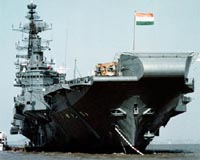
The Rise Of The Asian Navies.
Jul 11, 2008 Russia's Yantar Shipyard currently is building a second batch of three Type 1135.6 FFGs for the Indian navy.
The first three vessels of this model were built at the Baltic Sea Shipyard, but the contract for the latest three vessels has been awarded to the Yantar Shipyard, which has no experience building this type of missile frigate.
Apparently Russia intends to bail out the Yantar Shipyard, which has not received such an order in recent years through Russia's system of allocating contracts. For this reason, it is worth watching the progress of this construction project to see if the shipyard can deliver a quality product. India is also concerned whether the overall price of building these vessels will rise as a result.
India has also begun building its own indigenous aircraft carrier, which is proceeding faster than China's program. India is building its aircraft carrier at Cochin Shipyard and is expected to complete it in 2013. However, past experience has shown that the Indian navy's vessel construction projects are usually delayed by two to three years.
With the Italian Fincantieri Co. providing design assistance, this indigenous Indian aircraft carrier has a full-load displacement of 37,000 tons and will be powered by four LM-2500 heavy-duty gas turbines, with a maximum speed of 28 knots. China's first indigenous aircraft carrier also very likely will be powered by heavy gas turbines.
The design blueprint of the Indian aircraft carrier already has been published, with a deck length of 830 feet and a runway of 600 feet. The aircraft use ski-jump takeoff and landing. The steel plate used to build the aircraft was imported from Russia, and the cutting process was completed in 2007.
As for the Admiral Gorshkov aircraft carrier that India purchased from Russia, it should have been delivered to the Indian navy within this year, according to the original agreement. The retrofitted Admiral Gorshkov's full-load displacement has been increased to 45,400 tons, and it will be equipped with 12 MiG-29K fighters. India and Russia held the latest round of meetings concerning this aircraft carrier in February in Moscow, and the two sides reached a final consensus on the increased price of retrofitting the carrier. The new delivery time is now set at 2011.
It is not presently known what production plans the Chinese navy has in terms of the construction of large-tonnage surface battleships before 2010. Yet, judging from the current status of shipbuilding within the People's Liberation Army navy, and with two aircraft carriers entering service in the Indian navy before 2012, India will resume its absolute technological and tonnage lead in the construction of surface warships above 6,000 tons. Of course, with China initiating its aircraft carrier construction soon, such a trend may be reversed later.
As far as the construction of conventional submarines is concerned, China still holds an obvious lead. The PLA navy is already armed with two Yuan Class submarines, about 10 Song Class submarines, four Kilo 877 and eight Kilo 636M submarines.
The Indian navy has a fleet of more than 10 Kilo 636 and four Type 209 1500 submarines. India's most ambitious submarine construction plan is to build Scorpene Class submarines at its Mazagon Shipyard under license, code-named P-75.
The first batch of P-75s involves importing and assembling six submarines, and India plans to assemble the first P-75 independently in 2012. After that, production of the P-75 will proceed at the pace of one submarine each year. Based on this calculation, the whole project will not be completed until the end of 2017.
India's latest plan shows the Indian navy may very likely expand its Scorpene sub fleet to 12. In terms of shipbuilding technology and production craftwork, however, especially in such production processes as cutting, welding and spray-painting, the military vessels produced by China -- particularly those vessels built at the two shipyards in Shanghai -- are far superior to the Indian navy ships.


















No comments:
Post a Comment